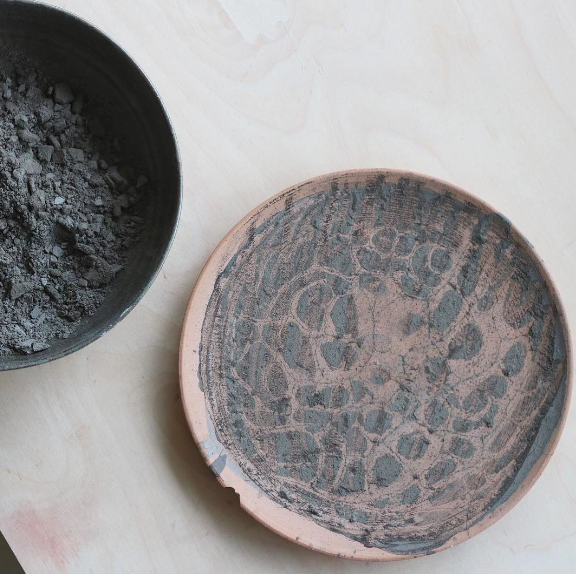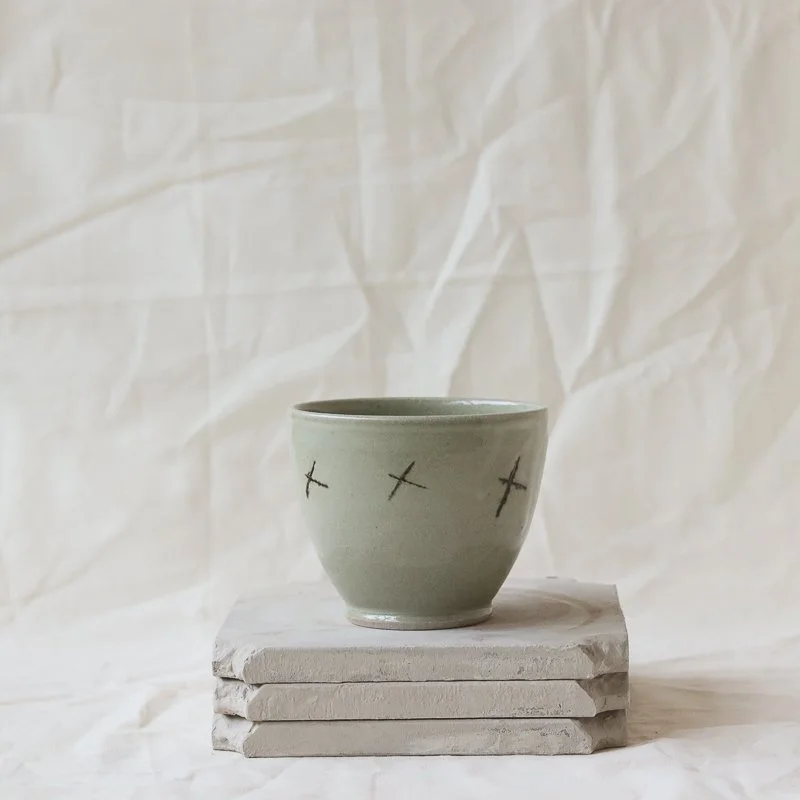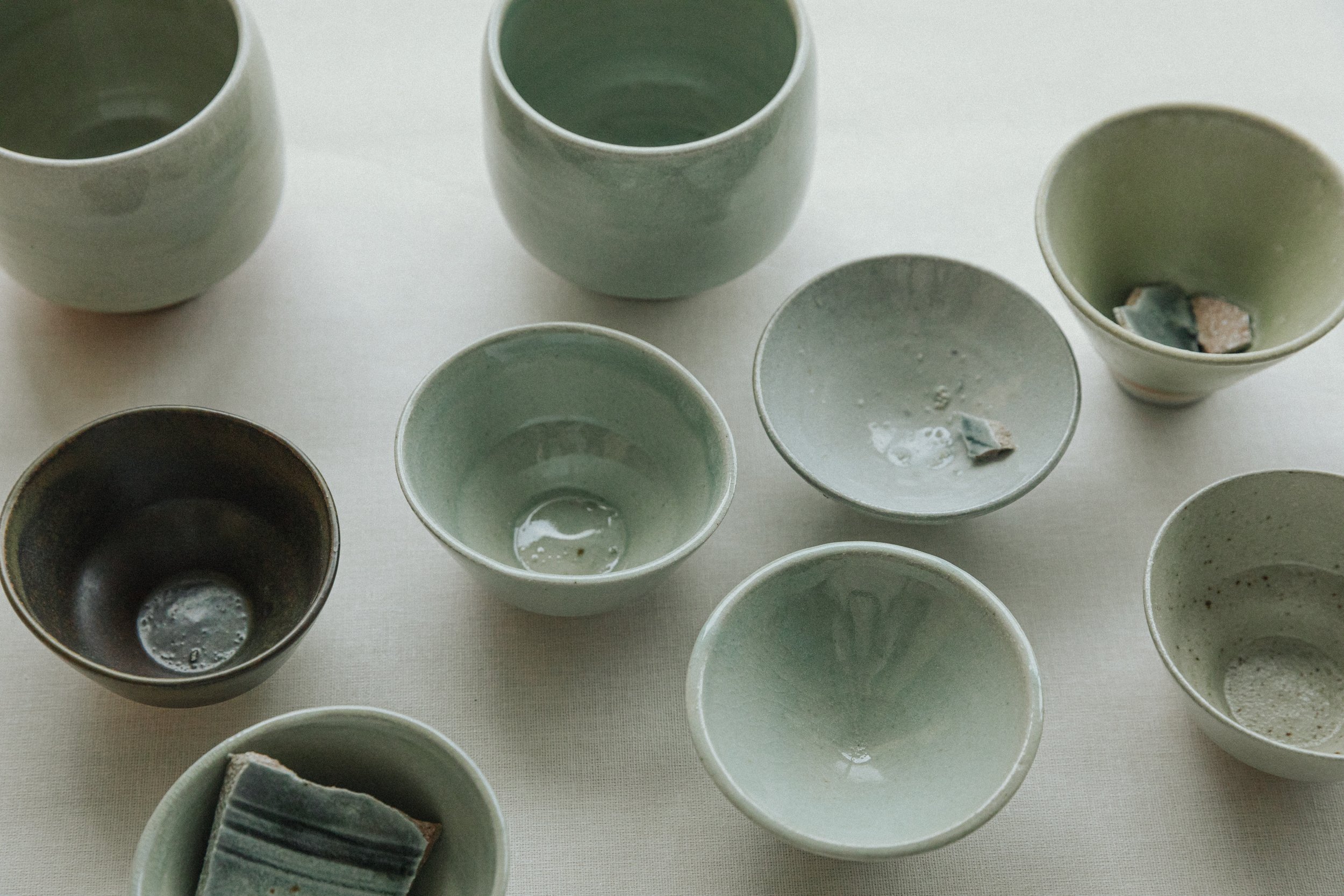A Gentle Rebellion
Last month I was invited to give a talk by the Yorkshire Artspace, for a group of ceramicists, all about the relationship between clay and storytelling. As someone who loves to write, I realised I hadn’t interrogated this aspect of our work in much detail before, and I found the process of putting together the talk fascinating. I thought I’d share elements of the talk in this journal post:
A Gentle Act of Rebellion
When we first started working with clay about ten years ago, our making was motivated by an interest in food and cooking. In those early days we found much pleasure in buying from other potters and building a small collection of functional pieces - not to be sat on a shelf but to be used. One of our favourite places to visit was (and is still) the David Mellor Kitchen shop and factory. Here we discovered the work and stories behind some of our favourite potters, including the late Richard Batterham, whose work is inspirational for us. We also visited the Matthew Darbyshire exhibition of the WA Ismay Collection at The Hepworth which was another point of inspiration for us in those early days - it was always the idea of collecting and using pieces that was interesting.
This initial interest in functionality became the backbone of our practice and it is why now we are still committed to producing functional pieces, even though it can sometimes be financially challenging to work in this way, as opposed to producing higher value single pieces.
I think it is important to acknowledge that producing handmade functional ware comes with difficulties in term of making profits. Some of our pieces, for example, mugs, have such a tight profit margin and some pieces are even loss making. It’s a really delicate balance being able to produce and sell enough of these pieces and over time we’ve learnt how to create a diverse portfolio of pieces.
When we’re working on a new design or embarking on a project, I often turn first to pots from the past for inspiration. Books, magazines, trips to museums etc. I want to know what materials were being used and why the form is as it is. Who was this pot made for and by whom? Where do they live, what do they eat, what does an ordinary day look like for them? And something I often think about is whether or not any of our own pots will survive the test of time and warrant the merit to kept in such a way. If so, what will the questions and answers be about our work and what context are our pots being produced in?
At this point I’ll highlight an obvious truth. Handmade things are expensive. Whilst I aspire to act as William Morris instructs, to ‘“Have nothing in your houses that you do not know to be useful or believe to be beautiful.”, this isn’t possible for all people. This fact led to a crisis of conscience for even Morris, as he found it hard to reconcile his passionate beliefs in "art for all" and the democratisation and reform of design with projects that involved , in his words, ”ministering to the swinish luxury of the rich”.
Despite his frustration, his work is still of great inspiration to us and surprisingly relevant today and we remember the context in which he worked. I ask myself, how can we produce functional pieces that are still relatively affordable whilst also being able to make our living? It is a difficult question and not always possible. This is all to say that, the answer to the question of future enquirers about who our work is for, or at least who it is purchased by, will inevitably have a socio-economic slant to it.
But the bigger story I want to convey is the context in which we are working in. that even though there are much cheaper, still beautiful, but nevertheless mass produced ceramics available, there are still people who want to buy and use slow-made handmade works of craft and support small businesses like ours.
So what is the context? Look around and you’ll notice that things, left under human control things have quickly become uniform, progress has been found in mass-production, diversity hampered. The relationship between humans and the material world isn’t necessarily a healthy one. Things are changing slowly and the conversation about bio-diversity is becoming more and more mainstream.
Certain crafts aren’t always sustainable, pottery can be one of them. We are using finite materials to produce our work and using fuel to fire our wares. Sometimes I wonder how we can justify this? For me it comes back to diversity also - lots of small independent makers and craftspeople preserving traditions opposed to, say, just a few factories - this is a healthier and more interesting landscape. I also think it starts with understanding our materials and having a relationship with where those materials come from.
Whilst we strive to run a successful commercial pottery which doesn’t over-produce. It can be a fine line between producing enough pieces to cover costs but not produce too much. But we also focus on educating ourselves about our main raw materials.
(image of processing / washing willow ash to be used in a glaze)
“So my thought is that in the grand scheme of things it’s a small thing but buying a mug from a potter who made the piece from start to finish, who holds the knowledge of the material and has worked hard over the years to learn the skills to make the piece - perhaps it is a stretch to say this but it’s an act of rebellion, albeit a gentle one. ”
A Balancing Act
If on the surface there is little aesthetic difference to a piece made by us in our studio and a mass-produced piece, this is why storytelling is so important to what we do. After all, just because something is mass-produced, it doesn’t mean that it is made without thought or skill, and in fact many of our processes will be the same. But the people who buy our work are investing in not only the piece itself but the story of its making.
Storytelling comes in many forms for us and often overlaps as a marketing strategy. From the literal forming of words to describe the pieces we make, to the photographs we choose to take and the way we communicate our practice to a wider audience. We actively use email campaigns, instagram and our own website as platforms for this type of storytelling and it is a fundamental part of what we do.
A recent project for Atelier Ellis, ’50 cups’ includes 50 unique forms which are reduction fired in the new YAS gas kiln. The project focusses on the idea that choosing a mug or drinking vessel is highly personal and subjective. We introduced mark making in the form of iron brushwork and faceting - each pot is individual and full of expression.
Being an online business as we are, we work carefully to make tableware that is not only completely handmade and produced in our studio, but is also very consistent in size, shape and glaze. If people aren’t able to pick things up and select what they want to buy in person, we need to be able to document this digitally and convey with words and images. So, best to have to only do this once a batch rather than every single pot. We’ve become good at doing this - throwing the same shapes, sized and learning to control our glazes to such an extent that we can rely on our processes for repeatability - in most cases. Of course many things can and do go wrong, as clay dictates.
I realised lately, when reading a review of our work in a newspaper, that maybe in some instances we’ve become too good at this. Maybe we’re making things too uniform, too neat, being too scrupulous. Does our work show the story of its making on its surface? Perhaps it’s time to re-wild our pots and celebrate the mark of the hand to an even greater degree. Incidentally, in our practice we’ve already been gradually introducing and incorporating some of these ideas over the last year or so. Here is a wood-fired piece from 2021 with a willow ash glaze.
An Ordinary Craft
Being a couple of potters rather than an individual has always been something extra to consider. It is less important for us to have made the work solely ourselves and we do have assistance from other potters and makers in the production of our work. In the early days the work was divided neatly in that Matt was the thrower and I was the glazer, but now things aren’t as cleanly cut. So how do we navigate this to our audience who are here for authenticity and the maker’s story?
In the Japanese ‘Mingei’ movement which can be roughly translated into English as ‘folk craft’, the origins of the movement were inspired by the nameless craftsmen making throughout Yi Dynasty in Korea (1392-1912).
The founder, philosopher Yanagi Soetsu, wanted to create a movement for Japan that distinguished ordinary crafts and functional pieces from higher forms of art. Mingei was a reaction to Japan’s rapid industrialisation and Western influence and sought to celebrate and educate the public on the beauty of Japanese crafts. The main pillars of the movement are that the crafts should be beautiful. Natural materials should be used, handmade and traditional methods and the design simple and functional. Pieces should also be able to be copied and reproduced in quantity meaning the works can be less expensive. Beauty was also to be found in the fact that the makers should always be anonymous and unknown.
I’m really fascinated by Mingei and the correlations this movement has with the closer to home Arts and Crafts Movement and also Studio Pottery movement in which the ‘ethical pot’ was a closely related idea introduced by Bernard Leach. The ‘ethical pot’ was a theoretical movement that favoured simple and utilitarian pots, with the belief that if made lovingly and in the right way could hold a spiritual and moral dimension. Whilst I don’t exactly follow these ideas with my own work I do inevitably draw influence, aiming to incorporate beauty, simplicity and functionality at all times - and how we communicate this is a responsibility.
I talk about responsibility here in the same way that in 1920s Japan Soetsu too felt a keen responsibility to educate and promote traditional common crafts for ordinary people. Now, today, even more, we have a responsibility to promote our traditional making processes in order to preserve them, for the sake of diversity. For us these communication methods may be using social media, writing blogs and so on. And this is why for me, solely producing pots without the storytelling aspect is not fulfilling, particularly our studio commits to the production of ordinary pots to be used as opposed to more expensive and ornamental pieces.
“And this is why for me, solely producing pots without the storytelling aspect is not fulfilling, particularly our studio commits to the production of ordinary pots to be used as opposed to more expensive and ornamental pieces. ”
Memory
Pottery can quickly become all encompassing and many people talk about their first encounters with clay as feeling like an addiction. It was no different for us, but particularly for Matt who had been doing a little soul searching, things clicked into place. He felt at home with this material - I suppose he had seen his sculptor father working with clay from a young age.
Within our work there is a certain amount of repetition and much of the skill we have honed over the years relies on muscle memory - to the extent that it becomes a part of our physical make-up. I wanted to explore the idea of memory and repeat application a little deeper and I wondered why some people - Matt being an example - are particularly adept at this type of work.
In the 2020 lockdown we became hooked on tracing our family trees and Matt discovered that his great grandfather had been a master thrower at Royal Doulton. His great-great grandfather was a potter too and his uncles, according to the census ‘clay labourers’. The story goes back further too, to France, and there is still a lot to explore. To Matt this is a happy coincidence but for me it is just part of a bigger story. Can there be a type of DNA memory, can our stories be within us all along, just waiting to be revealed?
But it is poignant that clay has memory too. Frustratingly, remarkably, if you knock a ware by accident and shape it back into form, it may well ‘remember’ in the kiln and revert back to the wrong shape. There’s a beauty in this relationship between our hands and ability, or inability to control the earth, the mud. We may try and forge ahead with writing our own stories of our work and lives but sometimes the story to be told is not entirely within our control.
Clay can be humbling and that is a wonderful story to tell.






